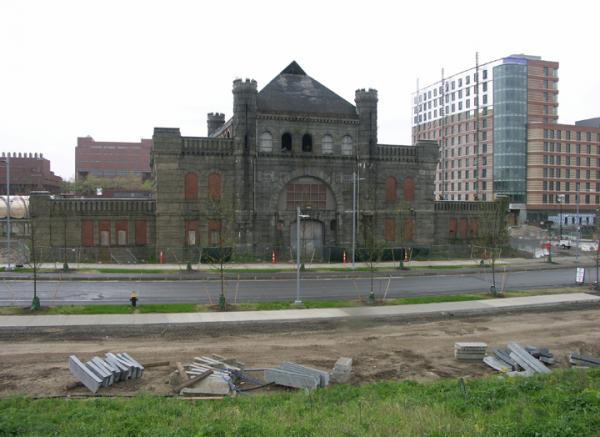October 25, 2018

A view of the east side of the pumping station. Image courtesy of Dorchester Historical Society.
The Calf Pasture Pumping Station, a towering, decaying 135-year-old granite building on Columbia Point that is owned by UMass Boston, has been named one of the state’s most-endangered historic resources, joining a handful of other notable structures across the commonwealth on the 2018 listing of Preservation Massachusetts.
Two adjoining diminutive gatehouses are included with the pumping station on the list, which has been compiled and published since 1993.
These buildings are a “visible manifestation of one of Boston’s great technological innovations in the field of metropolitan public utilities – a regional system of interceptor sewers to keep raw sewage out of the Back Bay and Boston’s inner harbor,” according to a release from Preservation Massachusetts, a statewide historic preservation organization.
Columbia Point served as the terminus of a public sewer system in the 1880s, with pipes carrying sewage under what today is Mt. Vernon Street out to the pumping station, which then moved the waste out to Moon Island. The building itself was designed by George Albert Clough, an architect of large public projects and institutional buildings, and completed in 1883.
The pump functioned for the next century as part of the Boston Main Drainage system, which later evolved into the Metropolitan Sewer District and encompassed several other systems, according to the preservation group.
“Inclusion of the Calf Pasture Pumping Station and its two gatehouses on the Most Endangered List not only recognizes the dangers to the buildings of being open to the weather and the possibility of them being lost to neglect, but it also brings attention to the historical importance of these buildings,” said Earl Taylor of the Dorchester Historical Society. In a statement he added, “Thank you, Preservation Massachusetts, for shining a spotlight on this symbol of technological innovation and of a turning point in the field of public health in late nineteenth-century Boston. Boston’s system of interconnecting sewers set an example for cities across the country.”
The monumental Richardson Romanesque structure, with its striking granite slab side and castle-like body, sits in the midst of middle of the Point in striking contrast to its modern-era surroundings, brand-new UMass campus buildings, the Massachusetts State Archives, the John F. Kennedy Presidential Library and Museum and the Edward M. Kennedy Institute for the United States Senate.
The preservation group noted that the ever-shifting, ever-denser landscape around the Calf Pasture buildings and the lack of distinct preservation or re-use goals “make its future uncertain. Surrounded by new buildings, the pumping station’s deteriorated state and the lack of a clear plan for its future are all the more evident.”
Although there are no clear plans for the iconic pumping facility, interim UMass Boston Chancellor Katherine Newman has been vocal about her desire to see something done with it.
“It’s very important to me, and I think probably to the community out here, to figure out how to do something really spectacular with the pump house, because the pump house will now be very visible,” she told the Reporter during an August tour of the campus’ new dormitories. “Before it was behind a whole bunch of us. And now it will be very visible and obviously it’s in dreadful condition, but it is a historic building that could be just stunning. So I’m excited about what the possibility will be over there.”
She was even more forceful about things at a campus town hall in mid-October. “That pump house — by hell or high water – that pump house is gonna be reborn,” she said, to applause from the gathered school community. “You see, it could be one of the most beautiful buildings on this campus. It’s going to be stunning, but I’m gonna have to barnstorm to raise the money for it and I will.”
The Boston Landmarks Commission voted on Oct. 9 to accept the Calf Pasture Pumping Station petition for further study, so the building could yet be designated as a Boston Landmark. Such a distinction could, advocates hope, raise its profile and encourage a closer look at its potential for reinvention.
“Columbia Point has changed drastically over the past 10, 25, 50 years, but one historic property has remained as a landmark for 135 years,” said Jim Igoe, the president of Preservation Massachusetts, in a statement. “It is time that this once beautiful property finally be restored and allowed to become an integral part of 21st century Boston at Columbia Point.”


